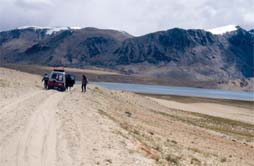Drying wetlands
 located at altitudes of 4,000-5,000 metres, the wetlands in the Changtang area of eastern Ladakh attract a large variety of wildlife as well as humans with their livestock. This area covering thousand of square kilometres lies within the boundaries of the Changtang Wilderness Area or the proposed High Altitude Cold Desert National Park. With total rainfall hardly exceeding 100 millimetres annually, the environment is semi-desert like with large dry steppes in open valleys, sporadically dotted with marshes and lakes. They are fed by small mountain rivers mainly during early summer, when the snow from the surrounding peaks melt. Towards autumn, many rivers cease to flow and wetlands dry out or water levels in the lakes decrease.
located at altitudes of 4,000-5,000 metres, the wetlands in the Changtang area of eastern Ladakh attract a large variety of wildlife as well as humans with their livestock. This area covering thousand of square kilometres lies within the boundaries of the Changtang Wilderness Area or the proposed High Altitude Cold Desert National Park. With total rainfall hardly exceeding 100 millimetres annually, the environment is semi-desert like with large dry steppes in open valleys, sporadically dotted with marshes and lakes. They are fed by small mountain rivers mainly during early summer, when the snow from the surrounding peaks melt. Towards autumn, many rivers cease to flow and wetlands dry out or water levels in the lakes decrease.
It is vital to conserve the slow-growing vegetation in the high altitude wetlands. But increased human interference is taking a toll on the fragile environment. In the 1950s and 1960s, moderate nomadic movement was observed in the region and pastures were lush and abundant. But over the last few decades, the vegetation cover has degraded mainly due to increased domestic livestock pressure.
The Changtang and Rupchu areas accommodate 41 villages and hamlets with a total population of 8,000-odd settled and nomadic (indigenous) residents and 1,500 Tibetan refugees. The latter crossed the borders during the early 1960s. The population growth rate is estimated to exceed 2.8 per cent. This is resulting in new settlements being built, new suitable lands being converted into agricultural fields and brooks being diverted to irrigate these areas.
Besides, the area also holds a substantial number of domestic animals. The Changtang area alone maintains an estimated 140,000 livestock population, 90 per cent comprising of sheep and goat and the remaining 10 per cent yak, zo (crossbreed between yak and cow) and ponies. These animals directly compete with the wild ungulates such as the Tibetan wildass, blue sheep, Tibetan argali or the rare Tibetan gazelle. The continuous growth of the domestic livestock increases not only pressure on herbivorous wildlife, but also leads to heavily overgrazed pastureland, resulting in wind erosion and accelerated devastation.
The ecosystems are also under pressure from the influx of tourists. Open to outsiders since 1974, the number of tourists visiting Ladakh has rapidly increased over the last two decades. Earlier the visitors were allowed to access only the Indus Valley west of Leh, Hemmis National Park and Zanskar area. But by securing a seven-day
Related Content
- Affidavit filed by the Chief Wildlife Warden, Assam on feral horses in Dibru-Saikhowa National Park (DSNP), 08/05/2025
- Report by the Rajasthan State Pollution Control Board on the proposed solid waste transfer facility near Ummed Ganj Pakshi Vihar Conservation Reserve, Kota district, Rajasthan, 25/08/2023
- Freshwater decline in India: NASA study
- Order of the Supreme Court of India regarding wetland conservation in India, 08/02/2017
- Spanish wetlands and wildlife sanctuary under threat: WWF
- New study uncovers the underlying causes of Delhi’s air pollution problems
